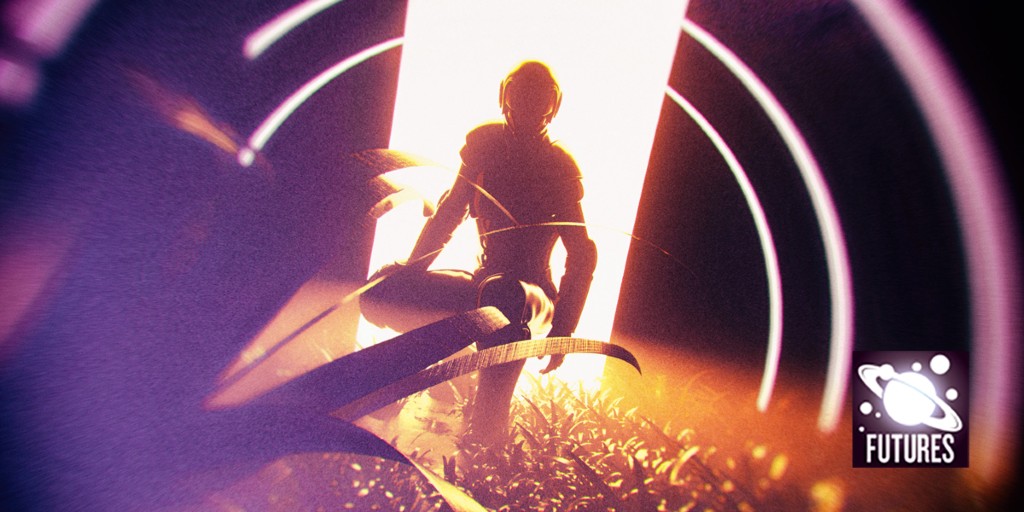History books like to focus on pivotal incidents such as peace treaties being signed by world powers, battles won or lost, and marriages brokered between dynasties. Those are all important, but history relies more often on quiet, boring moments that involve no major action, no blood, no drama.
For that reason, my assignment today is a spring garden in southern California. The vibrancy around me puts rainbows to shame. Bees buzz, birds sing. There’s an intrinsic sense that life has awakened in the world again — that there’s hope. Even I can recognize that. Me, a veteran of two wars, a marriage lost to the bottle. When I’m here working as a time cop, I don’t crave numbness. I feel, and I’m OK with that.
A woman walks along the far side of the pond. She’s best known by the name CinnamonBun98, and she’s about to create what will become one of the greatest masterpieces of the twenty-first century. She carries a slim digital tablet. Not the most recent model for 2037, but what she has is a luxury for a girl raised among mould-darkened walls where the nights pulse with gun shots.
I have watched her paint here more than a hundred times. I sometimes catch faint flashes of my past iterations on watch, or those of my comrades. Our garb almost entirely cloaks us to the human eye. In more distant centuries, our flitting presence would have been attributed to fairies or angelic visions.
Time-travel tech has been commercialized for a few years now — if you have ludicrous amounts of currency. The elite could view CinnamonBun98 with licensed time-travel docents who would ensure that their trip didn’t interfere with the timeline. That’s not enough for an awful lot of the hoity-toity. They crave a deeper experience with the floral masterwork that to many people feels like a religious experience.
My focus doesn’t stay on Cinn as she begins to work, her face scrunched and finger motions flurried. I watch the surrounding shrubberies, the draping trees, even the rippled water. This job, even more than my time as a soldier, has taught me never to underestimate the lengths to which people will go to get what they want.
A mote of light smears the air above a fringe of cattails. I sidle that way. Time cops train to move while cloaked to maximize the tech’s effectiveness. Rich people, they believe Hollywood action flicks. They think they can dash all over the place, cosy in their invisibility. Makes my job easier.
This person moves fast towards Cinn, but I move faster yet. I tackle them some 20 feet away from the artist. Before we hit the ground, I deploy a noise-cancelling bubble around us. My perp screeches, the sound echoing in our tight confines as their face impacts on a moss-fringed flagstone.
“No! I want to talk to her, I want to find out how she —” they blubber.
I rip back their cloaking layer to find period clothing — a pink tank top, khaki shorts, white canvas shoes. I wave my hand to perform a retinal scan for identification. “Savannah Olafson, age 27, she/her pronouns, American citizen. You’re in violation of multiple statutes that preserve the stability of our timeline —”
“I wasn’t going to mess things up! Never! The way she sees light — it’s like a glimpse of heaven itself shining through. I want to see what she sees!” Desperation and need warble in Savannah’s words. She’d collapse in worshipful tears if she actually stood before Cinn.
“We must minimize our interference in the past,” I say with firm gentleness. “I’m sending you back for processing.”
“No, please, I —”
I initiate a portal within our bubble and shove her through before she can babble about the millions of dollars she blew on this futile exercise or about how CinnamonBun’s work has changed her life.
The portal zips shut. I open the bubble and I resume my watch from a different spot, vigilant for further disturbances.
Cinn continues her work, oblivious. Her brow is furrowed. The garden before her is gorgeous, but how she translates the scene into digital form is what will impact millions of lives in the decades and centuries to come. Her work becomes a positive representation of humanity itself. It’ll be included foremost in a database deployed into deep space as we seek out new lifeforms. “Her painting of light is our light in the blackness of space,” is the famous description included.
I’m part of that light.
The motes in her painting are me dozens of times over, plus my comrades and fumbling interlopers. Our job is to minimize interference in the past, but like a person walking through the woods, it’s impossible to pass through without a single trace. CinnamonBun98 is an artist. She sees what most can’t, and interprets it, projects it.
For a long while, it bothered me that I’m part of something so beautiful. I mean, I’ve killed people. I’ve done some dark deeds for a pay cheque. I had to really hash things out with my shrink — and meditate on the painting itself — to eventually accept my place here, in the very work that could represent humankind when first contact comes.
People always fixate on the light in this scene, but that can’t exist without the dark.
I’m both and everything in between. The full package of the human experience. My role in history isn’t big and flashy like an atomic bomb. I’m a mere speck of light, and I belong here, too. I have a job to do.



More News
Publisher Correction: Interferon subverts an AHR–JUN axis to promote CXCL13+ T cells in lupus – Nature
We are junior scientists from emerging economies — the world needs more researchers like us solving global problems
Elusive high-energy neutrinos spotted at LHC